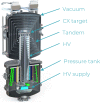A Review of Boron Neutron Capture Therapy: Its History and Current Challenges
- PMID: 35774489
- PMCID: PMC9238127
- DOI: 10.14338/IJPT-22-00002.1
A Review of Boron Neutron Capture Therapy: Its History and Current Challenges
Abstract
Mechanism of action: External beam, whether with photons or particles, remains as the most common type of radiation therapy. The main drawback is that radiation deposits dose in healthy tissue before reaching its target. Boron neutron capture therapy (BNCT) is based on the nuclear capture and fission reactions that occur when 10B is irradiated with low-energy (0.0025 eV) thermal neutrons. The resulting 10B(n,α)7Li capture reaction produces high linear energy transfer (LET) α particles, helium nuclei (4He), and recoiling lithium-7 (7Li) atoms. The short range (5-9 μm) of the α particles limits the destructive effects within the boron-containing cells. In theory, BNCT can selectively destroy malignant cells while sparing adjacent normal tissue at the cellular levels by delivering a single fraction of radiation with high LET particles.
History: BNCT has been around for many decades. Early studies were promising for patients with malignant brain tumors, recurrent tumors of the head and neck, and cutaneous melanomas; however, there were certain limitations to its widespread adoption and use.
Current limitations and prospects: Recently, BNCT re-emerged owing to several developments: (1) small footprint accelerator-based neutron sources; (2) high specificity third-generation boron carriers based on monoclonal antibodies, nanoparticles, among others; and (3) treatment planning software and patient positioning devices that optimize treatment delivery and consistency.
Keywords: BNCT; boron; neutron capture; neutron therapy; particle therapy.
©Copyright 2022 The Author(s).
Conflict of interest statement
Conflicts of interest: Wolfgang Sauerwein, MD, is the president of the German Society for Boron Neutron Capture Therapy. The authors have no additional conflicts of interest to disclose.
Figures




References
-
- Locher GL. Biological effects and therapeutic possibilities of neutrons. Am J Roentgenol Radium Ther Nucl Med . 1936;36:1–13.
-
- Chadwick J, Goldhaber M. The nuclear photoelectric effect. Proc Roy Soc A . 1935;151:479–93.
-
- Farr LE, Sweet WH, Locksley HB, Robertson JS. Neutron capture therapy of gliomas using boron. Trans Am Neurol Assoc . 1954;13:110–3. - PubMed
-
- Farr LE, Sweet WH, Robertson JS, Foster CG, Locksley HB, Sutherland DL, Mendelsohn ML, Stickley EE. Neutron capture therapy with boron in the treatment of glioblastoma multiforme. Am J Roentgenol Radium Ther Nucl Med . 1954;71:279–93. - PubMed
-
- Goodwin JT, Farr LE, Sweet WH, Robertson JS. Pathological study of eight patients with glioblastoma multiforme treated by neutron-capture therapy using boron 10. Cancer . 1955;8:601–15. - PubMed
Publication types
LinkOut - more resources
Full Text Sources
Research Materials
